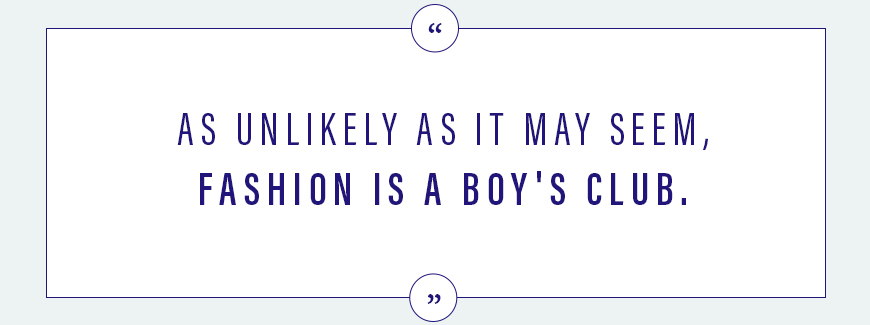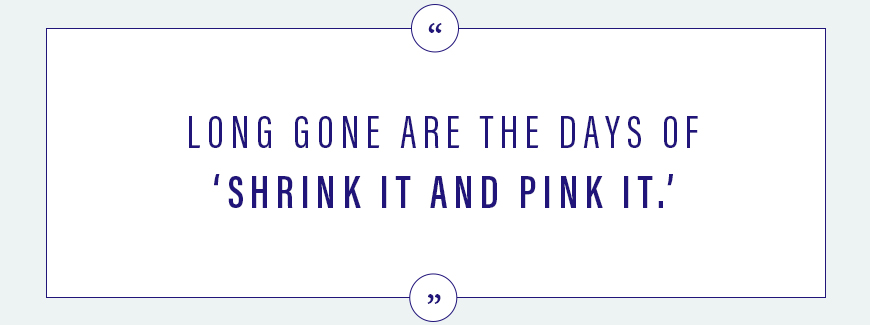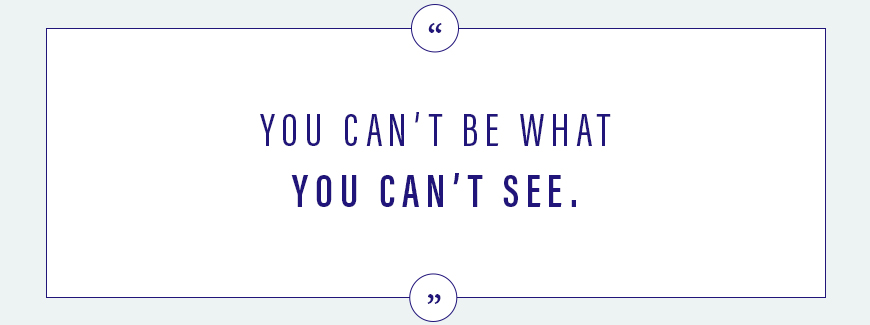Actually, it seems like even the most skillfully engineered sneakers can’t quite kick through the ol' glass ceiling. In a sample of activewear brands valued at over $500 million—Nike, Adidas, Puma, Under Armour, Lululemon, Athleta, and Reebok—Athleta is the only one with a woman in the CEO position. (Nancy Green, in case you want to add her to your #ladyboss vision board.) It’s also worth mentioning that of this cohort, only Lululemon and Athleta have executive leadership teams with a gender split that comes close to 50/50, based on publicly available data.
In a sample of seven activewear brands valued at over $500 million, Athleta is the only one with a woman in the CEO position.
This imbalance is especially glaring in the wake of the #MeToo movement, as male execs at some of the aforementioned active brands are being called out for misogynistic acts. Back in February, Lululemon CEO Laurent Potdevin resigned after he “fell short of standards of conduct,” which, according to Racked, involved cultivating a “toxic boy’s club culture.” A month later, Nike executives Trevor Edwards and Jayme Martin both left the company following reports that they “protected male subordinates who engaged in behavior that was demeaning to female colleagues,” and bullied “women and individuals from foreign countries." Several other male executives, including head of diversity Antoine Andrews, have since followed them out the door.
The fact is, there are a lot of benefits that come with having gender diversity within a company's corner suites. A 2012 survey by Harvard Business Review found that at every rung of the corporate ladder, women were rated as better leaders than their male counterparts, even when it came to so-called "masculine" strengths such as taking initiative and driving for results. And another recent study of nearly 3,000 Norwegian managers found that women scored higher than men on personality traits that are typical of skilled leaders, including emotional stability, extraversion, openness to new experiences, agreeableness, and conscientiousness.

{{post.sponsorText}}
Of course, there are plenty of male bosses who are totally honorable and great at their jobs. Yet, it’s worth questioning why women are so underrepresented in power positions—especially at the activewear brands that cater to them.
Keep reading to find out why there’s such a gender imbalance in the activewear industry, and how insiders believe it can be leveled out.

The legacy of gender imbalance in activewear
So why are there next to no women in C-suites at established activewear houses? First of all, says Carbon38 co-founder and CEO Katie Warner Johnson, it’s important to point out that the problem isn’t exclusive to brands making leggings and sports bras. “[Most] women's fashion companies in general are helmed and creatively directed by men,” she says. “As unlikely as it may seem, fashion is a boy's club.”
“As unlikely as it may seem, fashion is a boy's club.” —Katie Warner Johnson, Carbon38 co-founder and CEO
Then there’s the fact that the biggest activewear brands have been in business for many decades—and old hiring habits are hard to break. “Many were born in an era when men had all the power,” says Andréa Mallard, Chief Marketing Officer at Athleta. “Though their core offerings may have evolved to include the female consumer, there is still a legacy of male-centric hierarchies and norms they may be working through, even decades later. This often shapes which characteristics get valued and rewarded, thereby privileging people who ‘look most like’ or ‘act most like’ the typically male leaders that came before them.” (Research proves this: A recent study found that hiring managers tend to seek out candidates that are culturally similar to themselves.)
What’s more, the women’s activewear market is fairly new compared to its men’s counterpart, and the majority of resources—staffing included—are still being dedicated to product lines for dudes. “Since most activewear companies started with a men’s line first, it has benefitted from the most attention for a long, long time,” Mallard points out. “If your men’s offer is the biggest share of revenue, it also tends to be the biggest share of voice.” And with that, a fraternity is born.

Why gender parity in the activewear world matters
If there’s one bright spot in this lopsided story, it’s that we’ve seen such a massive wave of female-founded, female-driven fitness fashion start-ups emerge and thrive over the last decade—a phenomenon that indicates the days of male domination in the activewear space might be numbered.
In part, the athleisure revolution began in response to the fact that women weren’t getting enough seats at the traditional activewear table. “That is a large part of the impetus of starting Carbon38,” proclaims Johnson, who co-founded the brand along with Caroline Gogolak in an effort to bring a high-fashion feel to women's activewear, specifically. The company recently received a $15-million investment from Foot Locker. “I was exasperated with ill-fitting spandex sold at sport superstores and it was high time for a female perspective. Long gone are the days of ‘shrink it and pink it.’”
“In 2017, 68 percent of our hires were female, and 61 percent of the promotions we made within Reebok were women. Despite this, we know that we still have more work to do.” —Corinna Werkle, Reebok's VP of Women's
Aday co-founder Nina Faulhaber agrees with the idea that no one can build a brand for a woman quite like another woman. “When [co-founder Meg He and I] started Aday, we knew exactly what to design because we were creating our minimal, technical staples first and foremost for ourselves,” she says, noting that there isn’t a single guy on Aday’s team of 12. “How on earth would a man have known what a millennial women who follows her passions wants from her clothing?” (The company’s strategy is clearly working—Swedish fashion giant H&M helped fund a $2-million round of financing for Aday last fall.)
Given the success of these upstarts, legacy brands are taking notice and making some shifts of their own. Corinna Werkle, VP of Women’s at Reebok, says that increasing the number of women on its payroll is a major focus for the brand in 2018. “It is incredibly important for Reebok to have females in senior leadership and in charge of creating the best possible products,” she says, noting that more than half of the brand’s employees—including its Head of Performance Apparel and Head of US Marketing—are women. “In 2017, 68 percent of our hires were female, and 61 percent of the promotions we made within Reebok were women. Despite this, we know that we still have more work to do and are actively focused on progress.”

How to make gender equality happen in the activewear space
When it comes to making activewear brand leadership more of a co-ed endeavor, it’s largely going to depend on the women already at the top to help others ascend and join them. “It’s a cliché but it’s true: You can’t be what you can’t see,” says Athleta's Mallard. “As one of the few women executives to get to the C-suite in the activewear industry, I honestly believe I’m ethically required to send the elevator back down for the next woman.”
This philosophy is shared by the creators of Beyond Yoga, an apparel brand whose executive leadership team includes two women for every man. “It is crucial for the industry to make a conscious effort to mentor and retain their female staff,” says CEO Michelle Wahler. “As a female-founded company, supporting other women is fundamental to our company ethos. We identify and foster young talent, keeping an open line of dialogue so we can help them grow their careers."
"As one of the few women executives to get to the C-suite in the activewear industry, I honestly believe I’m ethically required to send the elevator back down for the next woman.”—Andréa Mallard, CMO, Athleta
Yes, it’s going to take time to undo years of conditioning, but there’s no question that it’s necessary. “Things that used to be seen as a weakness in a typically ‘female’ leadership style, like perhaps a tendency towards collaboration and consensus-building, are now being recognized as superpowers in the business world, as hallmarks of the modern business leader,” says Mallard. “As more women ascend the ranks, we’re getting far more diversity of leadership style to both evaluate and emulate.”
And with any luck, the more female bosses who rise up in all industries, the faster #MeToo culture will become a relic of the past.
Inspired to hop on the CEO track? Heed this advice on networking like a pro, and adopt this simple habit for major on-the-job Brownie points.
Loading More Posts...